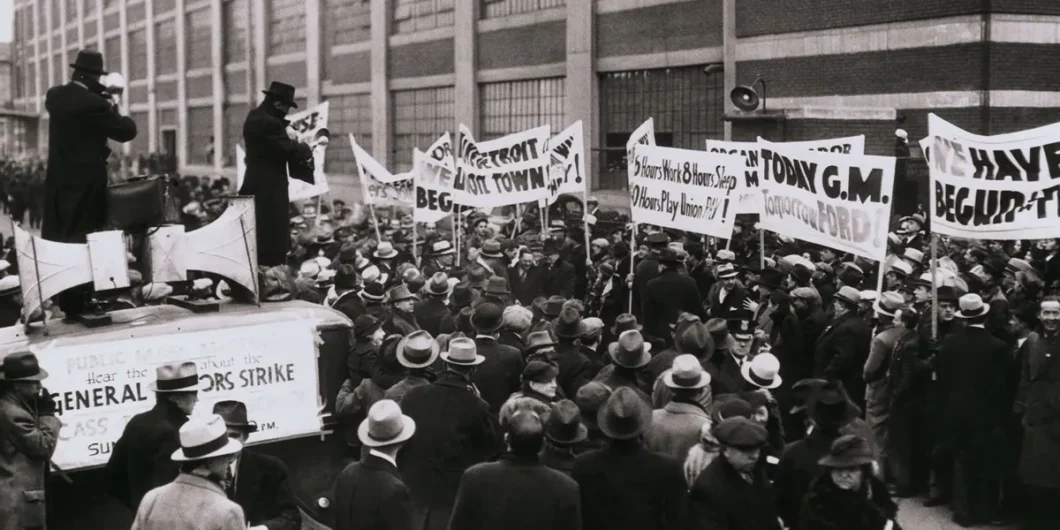What Caused American Economic Stagnation?
David Leonhardt’s Ours Was the Shining Future has much to recommend it in terms of tone and earnestness. The author avoids the screechiness so common in our modern debates. Leonhardt genuinely attempts to understand the ideas of his opponents. And I applaud his willingness to criticize a sacred cow or two of the political left.
Yet for all that, I find his book entirely unconvincing.
But to be fair to the author (and the reader), let me lay out Leonhardt’s basic arguments. The book’s thesis is that the US has faced significant challenges related to economic stagnation over the past four decades. He attributes this stagnation to the “neo-liberal” free market ideas of thinkers like Aaron Director, Robert Bork, and Milton Friedman and politicians like Ronald Reagan and Bill Clinton.
The book has two parts: “The Rise” and “The Fall.” For Leonhardt, “The Rise” occurs post-Gilded Age at the dawn of the twentieth century. In the bad old times of robber barons, workers’ wages and living conditions were poor. Income and wealth inequality, a key theme of the book, were near their zenith. Government laws favored corporations, businessmen, and employers at the expense of workers. That changes, the author argues, with the development of the organized labor movement in the US.
Prior to the 1930s, federal, state, and local governments were hostile to labor, and therefore strikes and organizing nearly always failed. But workers all over the US, from coal workers in Minneapolis to porters on railroads to workers on automobile assembly lines, united and gained political power in the 1930s. The Teamsters, the American Federation of Labor, the Congress of Industrial Organizations, and other labor unions found a sympathetic ear in Franklin Delano Roosevelt.
Political support for labor unions led to their rapid success and expansion: “Washington’s new friendliness to labor unions and the successful Flint strike led to a surge of labor activity.” Leonhardt claims that greater labor union membership “allowed ordinary people to acquire political and economic power that they had never previously had. That power allowed them to enjoy better, healthier, longer lives” during the golden age of American prosperity.
Labor unions matter because of what Leonhardt calls a “range of indeterminacy” for wages. Rather than a market wage emerging from the interplay of supply and demand, he posits that there can be a variety of wages consistent with market equilibrium. Whether worker wages fall on the high or low end of that spectrum is a matter of power—which is why strong unions promote high worker wages and greater income equality.
In laissez-faire or deregulated labor markets, on the other hand, “employees, left to act as individuals, have far less power than employers, and wages tend to settle at the low end of the range of indeterminacy.” The decline of labor unions is part of the story of “The Fall” in the second half of the book.
However, Leonhardt acknowledges that labor unions can cause problems for business and economic growth. What made the 1940s, 1950s, and 1960s such a golden era was not only organized labor flexing its muscles, but a recognition or acceptance on the part of businessmen that high worker wages and modesty in executive compensation were good for society and for the economy. Dwight D. Eisenhower figures positively in Leonhardt’s account for not being anti-labor and for engaging in what he sees as the other key component to economic prosperity: significant government investment.
Like many people who have not studied the 1930s closely, Leonhardt claims that the New Deal “raised wages and living conditions for workers across races and regions. It forged the world’s most prosperous working class and its largest middle class.” Continuations of government investment, such as building the interstate system, supported economic dynamism as well as income and wealth equality.
Similarly, Leonhardt argues that generous funding of scientific research “can allow people to live longer, healthier, richer lives and can lay the groundwork for unforeseen commercial applications that are indeed profitable.” Such government-funded research supports economic growth while reducing economic inequality. And, importantly, “A well-functioning capitalist economy depends on large investments in research that the free market, on its own, usually will not make.”
Massive subsidies for all levels of education promote a similar effect. Leonhardt says that “education is the investment that can turbocharge every other investment society makes.” Whether it is public K-12 schools, the G.I. bill, community colleges, or state universities, the more education the better.
Then, he makes a remarkable claim: “Since the 1970s, the share of national income devoted to government spending on education has remained flat”—as if government spending on education should grow as a proportion of the economy over time! It also flies in the face of the fact that spending per K-12 student has nearly doubled since 1970 in real inflation-adjusted terms.
“The Fall”
Leonhardt blames both the political left and the political right for the economic stagnation and other social problems that developed after 1980. He writes that the new left, made up of the “young intelligentsia,” abandoned organized labor in their attacks on capitalism and markets. This split the Democratic party between blue-collar workers and college-educated elites.
A naïve stance on immigration, one of the new left’s sacred cows, drove the wedge even further. Leonhardt writes that some restrictions on immigration are good for a country—especially for lower-skilled workers. Large numbers of immigrants can reduce wages for resident workers with whom they compete for jobs. The coalition of the political left in the 1950s and 1960s, which included huge numbers of such (blue-collar) workers, supported limiting how many immigrants could enter the United States each year. But “the modern Democratic Party has struggled to articulate an immigration policy beyond what might be summarized as: More is better, and less is racist. The party has cast aside the legacies of [Barbara Charline] Jordan, [Asa Philip] Randolph, and other progressives who made finer distinctions.” Restrictions on immigration were supported by Democrats in the golden years and even as recently as the 1990s, but not today.
But while Leonhardt deserves a pat on the back for offering substantive, if modest, criticism of the hyper-Progressive wing of the Democratic party, he clearly thinks the lion’s share of the blame for economic stagnation and social decay in the late twentieth and early twenty-first century goes to Republicans and mistaken market fundamentalists.
Our problems do not stem from the triumph of neo-liberal free market economics.
He devotes a whole chapter to the intellectual development of Robert Bork and the Chicago school of economics. He devotes another chapter to explaining how Reagan came to power and how the ideas of Milton Friedman, Aaron Director, Robert Bork, and other limited government advocates came to shape public policy in the legislative, executive, and most importantly, judicial branches of government.
His account of the intellectual and policy development of free market advocates is even-handed, even sympathetic. He gives their ideas and concerns a fair hearing, explores what is attractive about them, and acknowledges elements that he thinks are true. Yet for all this, Leonhardt lays most of our economic and social problems at their feet.
He damns the Reagan years and this more laissez-faire approach on two counts. Growth in GDP per capita, though solid during the Reagan years, was slower than GDP per capita growth during the Kennedy-Johnson administration and Franklin Roosevelt’s administration. In fact, Leonhardt claims, per capita GDP has grown somewhat faster during Democratic administrations than during Republican administrations.
But what is even worse, unforgivably really, in Leonhardt’s view is that income and wealth inequality soared after the pro-market reforms of the 1980s and 1990s. Deregulation, weakened labor unions, lower taxes, all these things benefited a narrow swath of society. He argues in no uncertain terms that advocates of limited government believed their policies would increase everyone’s prosperity and that this did not happen: “But no matter how genuine their motives, they were wrong.”
Drawing All the Wrong Conclusions
Unfortunately, Leonhardt’s reasonable and fair discussion of the ideas of his opponents’ founders on factual and theoretical shoals of error. Consider the theoretical problem of wage indeterminacy. While the market process of competition and the forces of supply and demand do not lead to perfect or immediate economic efficiency, they ruthlessly root out inefficiencies. While there is no guarantee that someone won’t be “underpaid” (itself a rather slippery notion), in a competitive system people are unlikely to be under, or over, paid for long.
At a deeper level, though, Leonhardt misses the forest for the trees. He talks about the successes of limited government advocates in the 1980s and 1990s yet misses the far more important trend of a relentlessly growing state. How can one really call the 1990s or 2000s “rough and tumble” capitalism in the mold of the Gilded Age? Government regulations proliferated, tax rates remained high and distortionary, legal restrictions on labor and on business formation increased, and governments continued to confiscate and spend an increasing share of society’s resources.
His lauding of government investment is also peculiar. Healthcare and education have become the most expensive sectors of the economy while failing to deliver results similar to other developed countries. That was not because they have been deregulated or lack government investment—just the opposite! Heavy regulation, oversight, restrictions, and massive government funding have made these the most dysfunctional sectors of the economy.
The income and wealth inequality story that Leonhardt hangs his hat on is riddled with problems. He relies on highly suspect data and narratives developed by Thomas Piketty, Gabriel Zucman, and Emmanuel Saez that overstate changes in income and wealth inequality in the twentieth century. Even more importantly, though, when it comes to studying living standards and economic development, one must consider economic mobility.
Leonhardt does so in the introduction and a couple of other places. He cites the work of Raj Chetty on the likelihood of children earning more than their parents. While that percentage has declined steadily for decades, it’s not an ideal measure. It doesn’t account for changes in wealth, which tends to grow over time and is often passed on to younger generations. Nor does it account for the changing social and cultural dynamics of young people, especially the children of the wealthy, often rejecting the occupational path of their parents.
Much of the narrative about income and wealth inequality tends to compare apples and oranges. They look at the wages of people in the bottom 20 percent (or bottom 99 percent) in 1970, 1990, and 2010 to make judgments about whether people’s income and standard of living are improving. Yet what they actually measure is what 30-, 40-, and 50-year-olds in those years earned compared to 30-, 40-, and 50-year-olds today. But nobody stays 30 forever. As people get older, they tend to move into higher income brackets. And no one argues that income or wealth has stagnated for higher income brackets.
Still, we shouldn’t be Pollyannaish. Some studies do suggest that income mobility in the US is declining. Many people face stagnating wages and have failed to accumulate much in the way of assets. But can we attribute this to weak labor unions? Or deregulation? No, much of the social and economic stratification we see stems from government distortions rather than competitive market dynamics. The culprit is far more likely to be economic stagnation due to government regulations and taxes or restrictions on labor due to licensing laws.
This leads back to my main criticism: the naïve characterization of the US economy as operating under the ideals of free market capitalism. Despite the reforms of the 1980s and 1990s, the US economy has become more and more heavily regulated and controlled by the federal government. Our problems do not stem from the triumph of neo-liberal free-market economics.
We must look elsewhere for what ails us.

